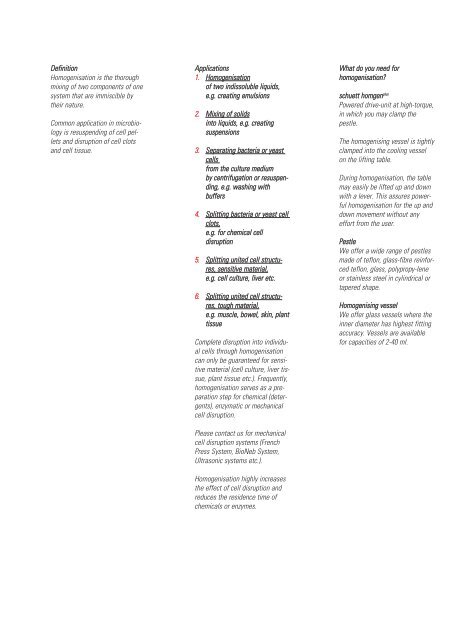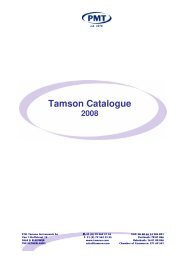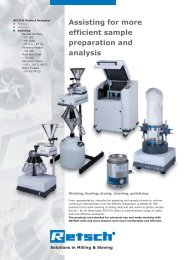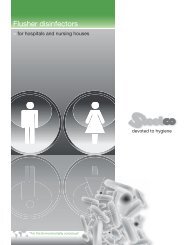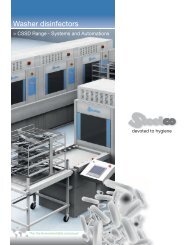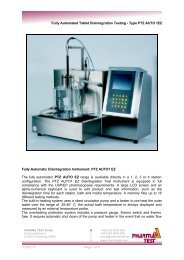Create successful ePaper yourself
Turn your PDF publications into a flip-book with our unique Google optimized e-Paper software.
Definition<br />
Homogenisation is the thorough<br />
mixing of two components of one<br />
system that are immiscible by<br />
their nature.<br />
Common application in microbiology<br />
is resuspending of cell pellets<br />
<strong>and</strong> disruption of cell clots<br />
<strong>and</strong> cell tissue.<br />
Applications<br />
1. Homogenisation<br />
of two indissoluble liquids,<br />
e.g. creating emulsions<br />
2. Mixing of solids<br />
into liquids, e.g. creating<br />
suspensions<br />
3. Separating bacteria or yeast<br />
cells<br />
from the culture medium<br />
by centrifugation or resuspending,<br />
e.g. washing with<br />
buffers<br />
4. Splitting bacteria or yeast cell<br />
clots,<br />
e.g. for chemical cell<br />
disruption<br />
5. Splitting united cell structures,<br />
sensitive material,<br />
e.g. cell culture, liver etc.<br />
6. Splitting united cell structures,<br />
tough material,<br />
e.g. muscle, bowel, skin, plant<br />
tissue<br />
Complete disruption into individual<br />
cells through homogenisation<br />
can only be guaranteed for sensitive<br />
material (cell culture, liver tissue,<br />
plant tissue etc.). Frequently,<br />
homogenisation serves as a preparation<br />
step for chemical (detergents),<br />
enzymatic or mechanical<br />
cell disruption.<br />
Please contact us for mechanical<br />
cell disruption systems (French<br />
Press System, BioNeb System,<br />
Ultrasonic systems etc.).<br />
Homogenisation highly increases<br />
the effect of cell disruption <strong>and</strong><br />
reduces the residence time of<br />
chemicals or enzymes.<br />
What do you need for<br />
homogenisation?<br />
schuett homgen plus<br />
Powered drive-unit at high-torque,<br />
in which you may clamp the<br />
pestle.<br />
The homogenising vessel is tightly<br />
clamped into the cooling vessel<br />
on the lifting table.<br />
During homogenisation, the table<br />
may easily be lifted up <strong>and</strong> down<br />
with a lever. This assures powerful<br />
homogenisation for the up <strong>and</strong><br />
down movement without any<br />
effort from the user.<br />
Pestle<br />
We offer a wide range of pestles<br />
made of teflon, glass-fibre reinforced<br />
teflon, glass, polypropy-lene<br />
or stainless steel in cylindrical or<br />
tapered shape.<br />
Homogenising vessel<br />
We offer glass vessels where the<br />
inner diameter has highest fitting<br />
accuracy. Vessels are available<br />
for capacities of 2-40 ml.


